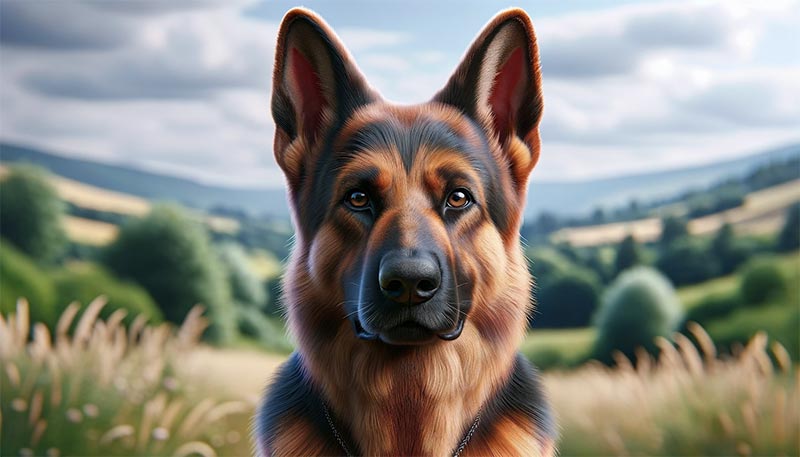The German Shepherd, renowned for its intelligence, loyalty, and versatility, stands as one of the most popular dog breeds worldwide. Originally bred for herding, they have transcended their pastoral roles to become excellent companions, service dogs, and law enforcement partners.
This blog post delves into the distinct characteristics of the German Shepherd, providing insights into what makes them so unique and beloved.
Physical Attributes
1. Size and Build: German Shepherds are large dogs with a muscular build. Males typically weigh between 65-90 pounds, while females are slightly smaller, weighing 50-70 pounds. They possess a noble, poised stature, with a height ranging from 22 to 26 inches at the shoulder.
2. Coat and Color: They boast a double coat comprising a dense outer layer and a softer undercoat. Their coat colors vary widely, with the most common being tan/black and red/black. However, they can also be found in solid black, blue, gray, and white.
3. Distinctive Features: A German Shepherd’s ears are a standout feature – large, erect, and open at the front. Their almond-shaped, dark eyes exude intelligence and alertness. Their bushy tail, which hangs with a slight curve, adds to their striking appearance.
Temperament
4. Intelligence: German Shepherds are exceptionally intelligent, ranking third in Stanley Coren’s “The Intelligence of Dogs”. This intelligence makes them highly trainable, adept at learning various tasks and commands swiftly.
5. Loyalty and Protective Nature: They are fiercely loyal to their families, often forming a strong bond with one particular family member. Their protective instincts make them excellent guard dogs, always alert and ready to defend their loved ones.
6. Versatility: This breed is known for its adaptability, excelling in various roles such as police work, search and rescue, and service dog duties. Their versatility also makes them suitable for different living environments, from spacious rural homes to urban apartments, provided they get enough exercise.
Health and Lifespan
7. General Health: While robust, German Shepherds are prone to certain health issues like hip dysplasia, elbow dysplasia, and bloat. Regular veterinary check-ups and a healthy diet are crucial for their well-being.
8. Lifespan: With proper care, a German Shepherd can live approximately 9 to 13 years. Active lifestyles and mental stimulation contribute significantly to their longevity.
Care and Maintenance
9. Exercise Needs: German Shepherds require regular exercise to maintain their physical and mental health. Activities like walking, running, and agility training are ideal.
10. Grooming: Their double coat demands regular grooming, especially during shedding seasons. Brushing a few times a week and occasional baths will keep their coat in good condition.
11. Training and Socialization: Early socialization and consistent training are vital. Their intelligence and eagerness to please make training a rewarding experience. Socialization helps in managing their protective instincts and ensures they are well-adjusted.
Final Thoughts
The German Shepherd is a breed that epitomizes loyalty, intelligence, and versatility. Their physical attributes, ranging from their noble stature to their expressive eyes, combined with their remarkable temperament, make them an exceptional breed.
While they require regular exercise, grooming, and health care, the rewards of having a German Shepherd as a companion are immense.
Their adaptability and eagerness to learn make them suitable for various roles and environments, proving them to be more than just pets, but rather, invaluable members of any family or team.
FAQs on German Shepherd Characteristics
Q: Can German Shepherds adapt well to hot climates?
A: German Shepherds can adapt to a variety of climates, including warm ones. However, due to their dense coat, they are more susceptible to overheating. It’s important to provide them with a cool, shaded area during hot weather and ensure they have access to plenty of water.
Q: Are German Shepherds good with children?
A: Yes, German Shepherds can be great with children, especially when raised with them from a young age. They are protective and often patient, but interactions should always be supervised, particularly with younger children, to ensure the safety of both the child and the dog.
Q: How much food does a German Shepherd typically require?
A: The amount of food a German Shepherd needs depends on their age, size, activity level, and health. On average, an adult German Shepherd might consume about 2 to 3.5 cups of dry dog food per day, split into two meals. However, it’s best to consult with a veterinarian for specific dietary recommendations.
Q: Do German Shepherds require professional training?
A: While German Shepherds are highly trainable, professional training is not a necessity but can be beneficial. Owners who are inexperienced with dogs or this specific breed might find professional training helpful for both the dog and themselves.
Q: Are German Shepherds prone to any specific behavioral issues?
A: German Shepherds, if not properly trained and socialized, can develop behavioral issues like any other breed. These can include separation anxiety, aggression, and excessive barking. Consistent training and early socialization can help mitigate these issues.
Q: How often should a German Shepherd be taken to the vet?
A: German Shepherds should have an annual check-up with a veterinarian. However, if there are health concerns or as the dog ages, more frequent visits may be necessary. Regular veterinary care is crucial for maintaining their health and addressing any issues early on.
Q: Can German Shepherds live in an apartment setting?
A: German Shepherds can live in apartments as long as their exercise and mental stimulation needs are met. They are active dogs and require sufficient space and daily activities to stay healthy and happy. Lack of exercise and stimulation can lead to destructive behaviors.
Q: Do German Shepherds get along with other pets?
A: German Shepherds can get along with other pets, especially if they are raised together or properly introduced. However, due to their strong prey drive, careful introduction and supervision are important when they are around smaller animals.



